KoiBot
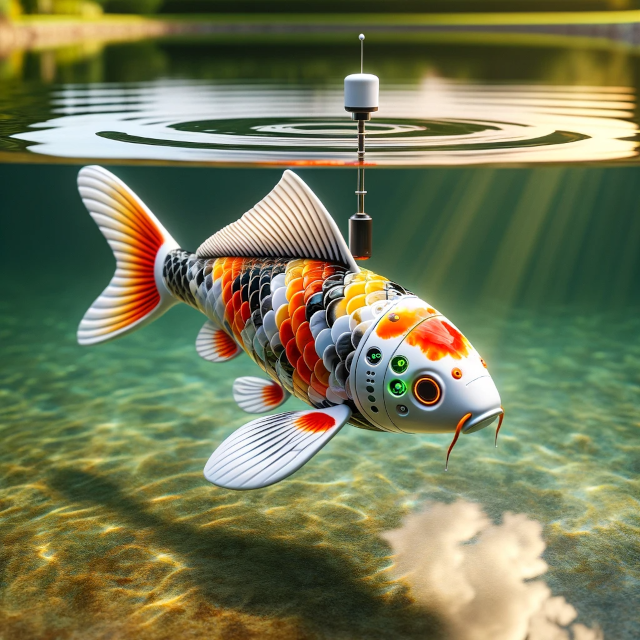
More to come ...
Kohaku
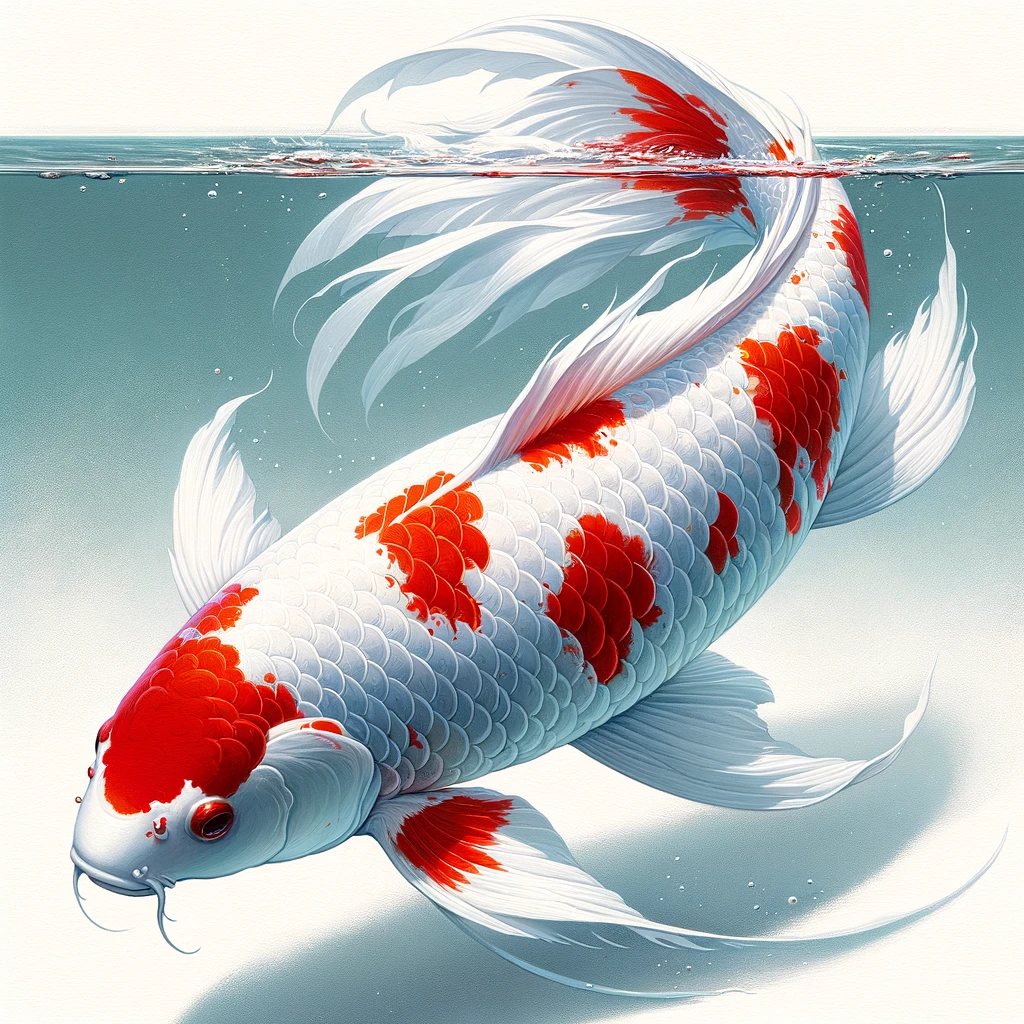
A Kohaku koi is a variety of ornamental fish that is highly prized for its simplicity and beauty. The name "Kohaku" translates to "red and white" in Japanese, which succinctly describes its coloration. Here are some of the defining characteristics of a Kohaku koi:
-
Coloration: Kohaku koi have a pristine, snowy white base color. Atop this white base are deep, vibrant red (hi) markings. The clarity of the white and the intensity of the red are both highly valued and play a significant role in the fish's overall aesthetic appeal.
-
Patterns: The red markings should be well-balanced and artistically distributed across the body. High-quality Kohaku will have a consistent, deep red pattern from the head to the tail. The edges of the red patches, known as the "kiwa," should be sharp and clear against the white background, without bleeding or blurring.
-
Body Shape: A desirable Kohaku should have a strong, elongated body, indicative of good health and genetics. The ideal shape is neither too slim nor overly bulky.
-
Fins and Tail: The fins and tail of the Kohaku are typically white and should be proportional to the body, aiding in graceful movement through the water.
-
Head Marking: Some Kohaku have a red mark on the head, which can be particularly prized if it is well-shaped and positioned. However, the head may also be completely white.
-
Scale Quality: For the Kohaku, as with many koi, the quality of the scales is important. The scales should be uniform and neatly arranged, adding to the visual texture of the fish without disrupting the pattern's clarity.
In koi shows and among enthusiasts, the beauty of a Kohaku is judged by these criteria, as well as the overall harmony of the pattern and body. Kohaku koi are often seen as the quintessential variety in the koi hobby and set the standard for the appreciation of all other koi varieties.
Sanke
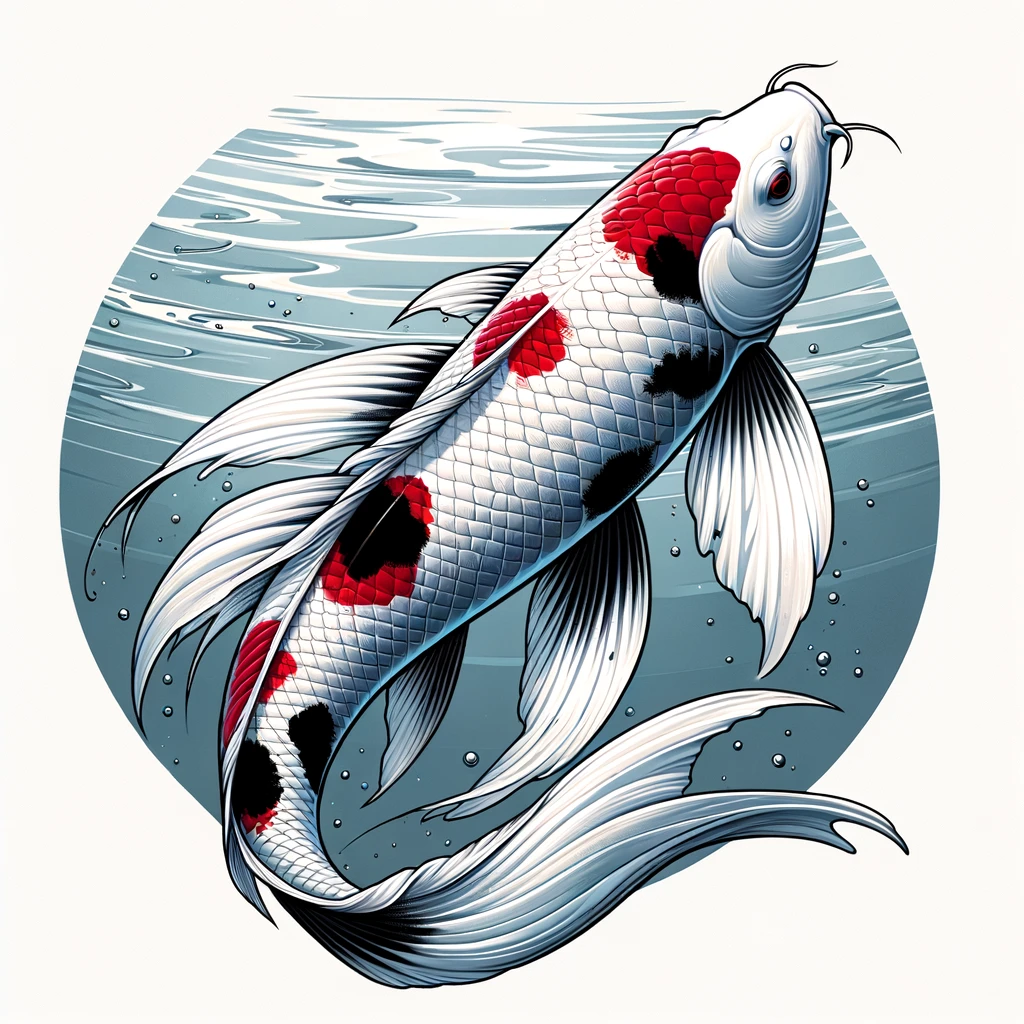
A Sanke, formally known as Taisho Sanshoku, is another highly admired variety of koi, notable for its elegant white base with vibrant red and black markings. Here’s what sets the Sanke apart:
-
Coloration: The Sanke has a bright white base, known as “shiroji,” which serves as the canvas for its pattern. On top of this, it has red (hi) and black (sumi) markings. The contrast between the three colors is a critical aspect of its beauty.
-
Red Markings: The red on a Sanke is similar to that of the Kohaku, with the red pattern ideally being rich and evenly distributed. It should not extend below the lateral line of the fish.
-
Black Markings: The black spots or patches should be well balanced and artistically placed. Unlike the red markings, the black spots can appear on the top of the back and sometimes on the fins. The quality of the black is judged by its lacquer-like sheen and depth.
-
Pattern Symmetry: The balance and symmetry of the Sanke’s pattern are essential. While perfect symmetry is rare, the pattern should be aesthetically pleasing and harmonious.
-
Body Shape: As with the Kohaku, a good Sanke should have a strong and well-proportioned body shape. It should exhibit the standard koi silhouette that is neither too slim nor overly broad.
-
Fins and Tail: Typically, the fins and tail of a Sanke should be predominantly white, but they may have small sumi (black) markings that are not considered a fault if they are balanced.
-
Scale Quality: The scales of a Sanke should be uniform and contribute to the overall smooth appearance of the fish. The edges of the colored markings, particularly where the black meets the white, should be crisp and clear.
Sanke koi are judged on the quality of each color, the sharpness of the pattern edges, and the overall impression of harmony and beauty. The name "Sanke" comes from the combination of its three colors (red, white, and black), and the variety has been cherished in the koi community since the Taisho era in Japan when it first became popular.
Showa
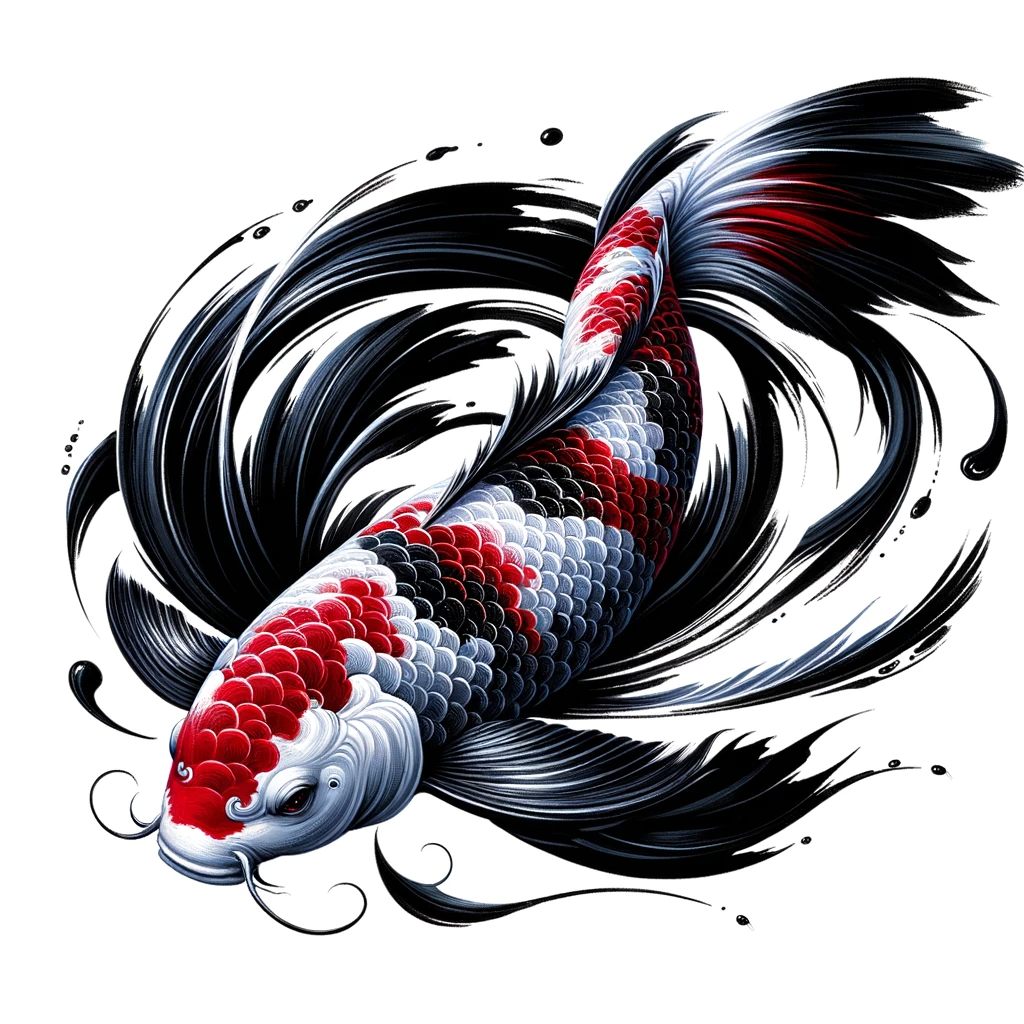
A Showa Koi, officially known as Showa Sanshoku or Showa Sanke, is a popular variety of koi fish that is cherished for its vibrant and complex patterning. Here are the distinguishing features of a Showa Koi:
-
Base Color: The Showa has a black base color, known as "sumi". This is the fundamental difference between Showa and Sanke, where the latter has a white base.
-
Patterning: On top of the black base, Showa koi exhibit red (hi) and white (shiroji) patterns. The red and white should appear as if they are painted on top of the black, rather than the black appearing as patches on a red and white background.
-
Sumi Quality: The black color on a Showa is one of its most critical features. It should be deep, lacquer-like, and well-balanced, contributing to the fish’s three-dimensional appearance.
-
Hi Patterning: The red markings should be bright and may cover more of the body than on a Sanke. Good quality Showa will have hi that is evenly distributed and does not impede the appreciation of the sumi underneath.
-
Shiroji Quality: The white areas on a Showa should be pure and serve as a contrast to both the hi and sumi, helping to define the edges of these colors and enhance the overall pattern.
-
Fins and Face: Showa koi can have sumi on their fins and faces, which is not common in Sanke koi. The pectoral fins often have a striped pattern known as "moto goro".
-
Balance and Harmony: The beauty of a Showa is often judged by the balance and interplay of the three colors. The patterns should be aesthetically pleasing and create a harmonious look.
-
Body Shape: The ideal Showa has a symmetrical and well-proportioned body shape that is typical of koi, neither too slim nor too round.
Showa koi are dynamic and can change as they mature, with sumi deepening and patterns evolving over time, which makes them particularly fascinating to koi enthusiasts. They are a staple variety in koi shows and are appreciated for their boldness and complexity.
Asagi
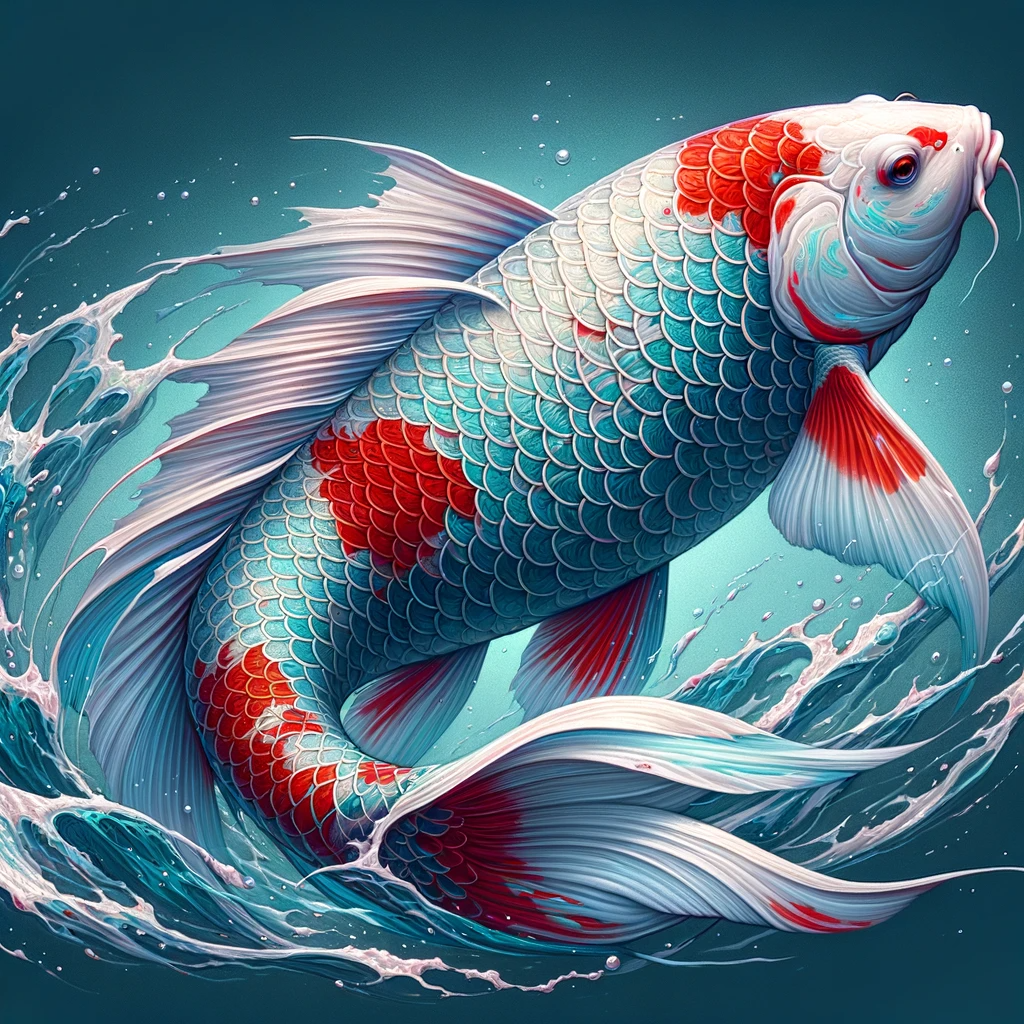
An Asagi koi is a traditional variety of koi fish known for its tranquil and subtle beauty. Here are the key characteristics that define an Asagi:
-
Coloration: Asagi koi are primarily recognized by their blue coloration. The blue can range from a pale, sky-like blue to deep indigo. This blue is often described as a "net" pattern across the back of the fish, known as "fukurin," where each scale is edged in a lighter color, giving a netted appearance.
-
Hi Plates: The sides of an Asagi feature a red or orange color (hi), which typically starts from the belly and can extend up the sides and even onto the base of the fins and gills. The red should not overpower the blue but complement it.
-
Head: The head of an Asagi should be a light color, often pale blue or grey, and free from any hi (red) coloration. Clear and unblemished heads are preferred.
-
Scales: Asagi koi have a reticulated scale pattern, with each scale clearly outlined. The quality of the scales is a significant factor, with crisp, uniform edges being highly valued.
-
Body Shape: Like other koi varieties, Asagi should have a strong and well-proportioned body. They should appear balanced and streamlined.
-
Fins: The fins of an Asagi are typically clear or lightly colored, with no speckling or discoloration. They should be proportional to the body and contribute to the fish's overall grace when swimming.
-
Balance of Pattern: Although Asagi koi are more subtle than other koi varieties, the balance between the blue and red is crucial. It should be aesthetically pleasing and not overly dominated by either color.
Asagi koi are one of the oldest types of koi and are highly respected among koi enthusiasts. Their serene color patterns are reminiscent of the traditional Japanese aesthetic, evoking calmness and a sense of ageless beauty.
Shusui
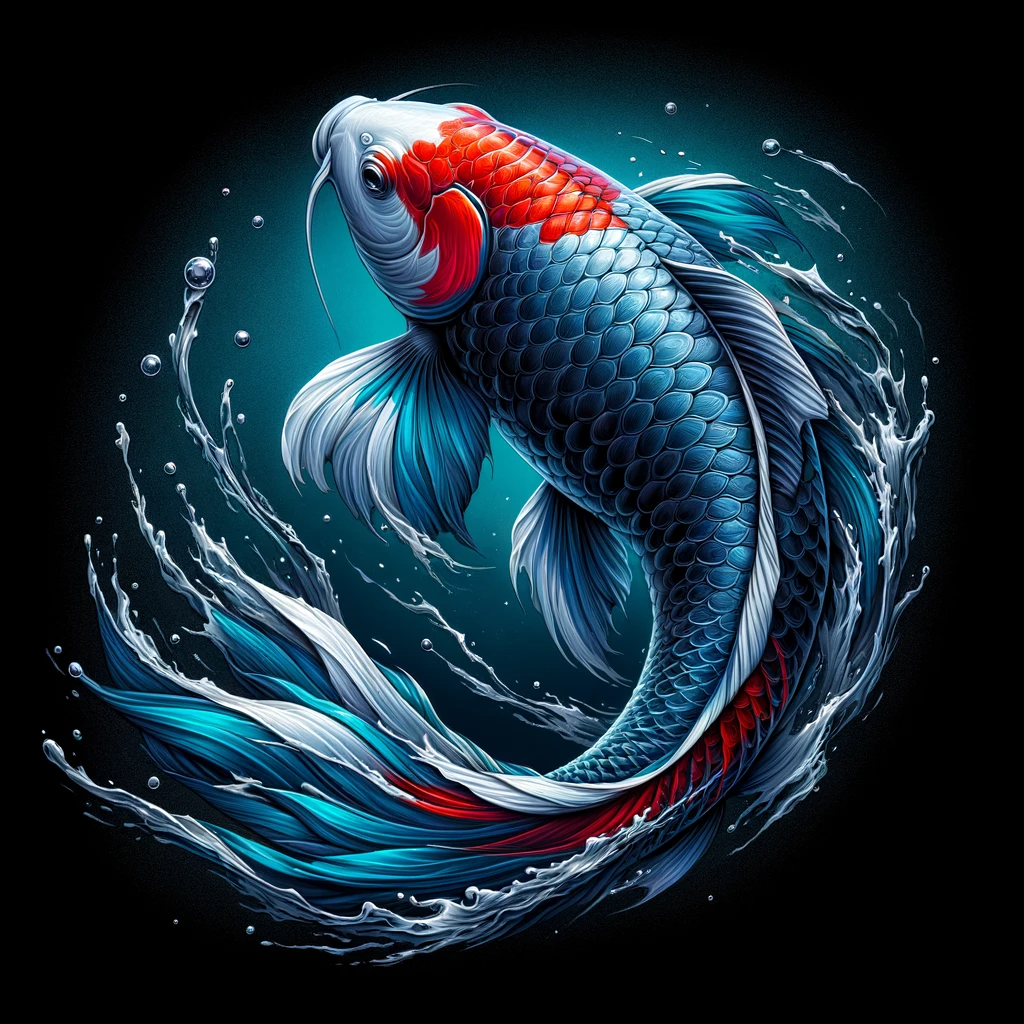
The Shusui koi is a unique and striking variety of koi fish, notable for being the scaleless (doitsu) version of the Asagi koi. It was developed in the early 20th century and has distinctive features that set it apart from other koi:
-
Scalation: The most prominent feature of Shusui koi is the line of large, blue scales running along the dorsal line from head to tail. This row of scales is often referred to as the "zipper" due to its appearance. The rest of the fish's body is scaleless, although there may be smaller scales on the lateral lines.
-
Coloration: Shusui koi exhibit a beautiful sky-blue to deep indigo color on their backs, much like the Asagi. The intensity of the blue can vary among individuals and may change as the fish matures.
-
Hi Plates: On the sides, below the lateral line, Shusui koi display red or orange (hi) coloring that can extend from the cheeks, under the sides, and down to the belly. The hi should be well-defined and can range in hue from deep red to a more subdued orange.
-
Head: The head of a Shusui is typically clear and unmarked, but some may have red or orange coloration on their cheeks and gill plates.
-
Body Shape: A good Shusui should have a strong, robust body shape, indicative of health and vitality. The body should be neither too thin nor too round, maintaining the typical koi silhouette.
-
Fins: Their fins are usually clear or white, but they can also have hi markings. The pectoral fins may show a blue edging.
-
Pattern Balance: The balance of the blue back and red underside is an essential aspect of the Shusui's beauty. The delineation between these colors should be clear, and the overall pattern should be symmetrical and aesthetically pleasing.
The Shusui koi's distinctiveness and streamlined appearance make it a favorite among koi enthusiasts, and its clarity of color and pattern is highly valued in koi competitions and shows.
Ogon
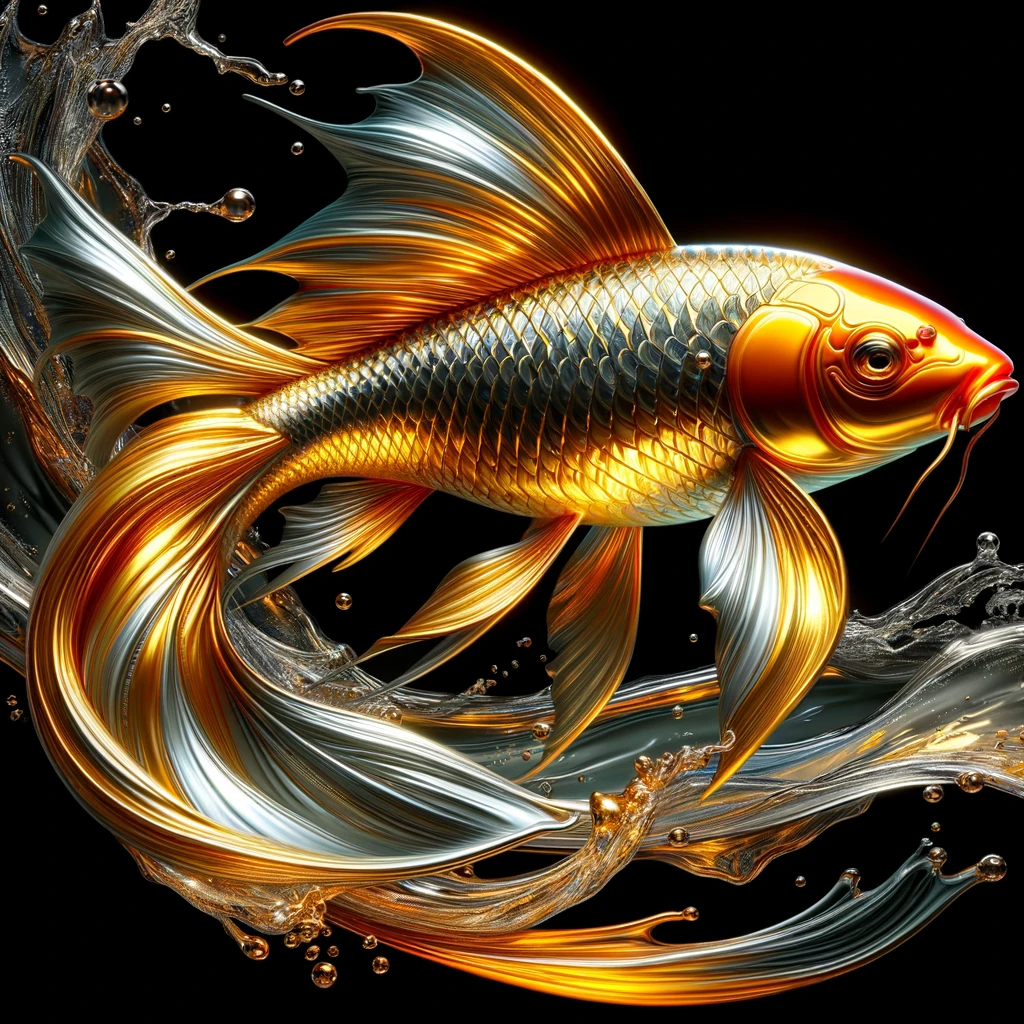
An Ogon koi is a captivating and highly sought-after variety known for its single, metallic color. It is a relatively modern koi variety that falls under the broader category of Hikarimono, which means "shining things" in Japanese. Here are the defining characteristics of an Ogon koi:
-
Coloration: Ogon koi are known for their solid, uniform color that has a metallic sheen. The most common colors are gold (often referred to simply as Ogon), silver (Platinum Ogon), and orange (Hariwake Ogon, which actually has two colors but retains the metallic luster).
-
Luster: The metallic luster of the Ogon is its most important attribute. The skin should have a shiny, reflective quality that makes the fish stand out, especially in sunlight.
-
Scale Quality: While Ogon koi can be either fully scaled or scaleless (doitsu), the quality of the scales or skin should be such that it enhances the fish's metallic shine. The scales should be even and add to the overall luster without diminishing the uniformity of the color.
-
Body Shape: Ogon koi should have a robust and well-proportioned body. They are often bred for a strong, thick build that complements their striking coloration.
-
Fins: The fins of an Ogon should be clear of any blemishes or discoloration and should match the body's color and luster.
-
Size: Ogons are known for growing quite large, and a larger specimen with a good body shape and lustrous skin is especially prized.
-
Presence: Ogon koi are appreciated for their presence in the pond. Their singular color and metallic sheen make them a focal point and they often serve as a contrast to more patterned varieties.
The simplicity and elegance of Ogon koi make them a popular choice for both beginners and experienced koi keepers. Their strong, singular color is a statement of beauty in koi ponds and competitions.
Tancho
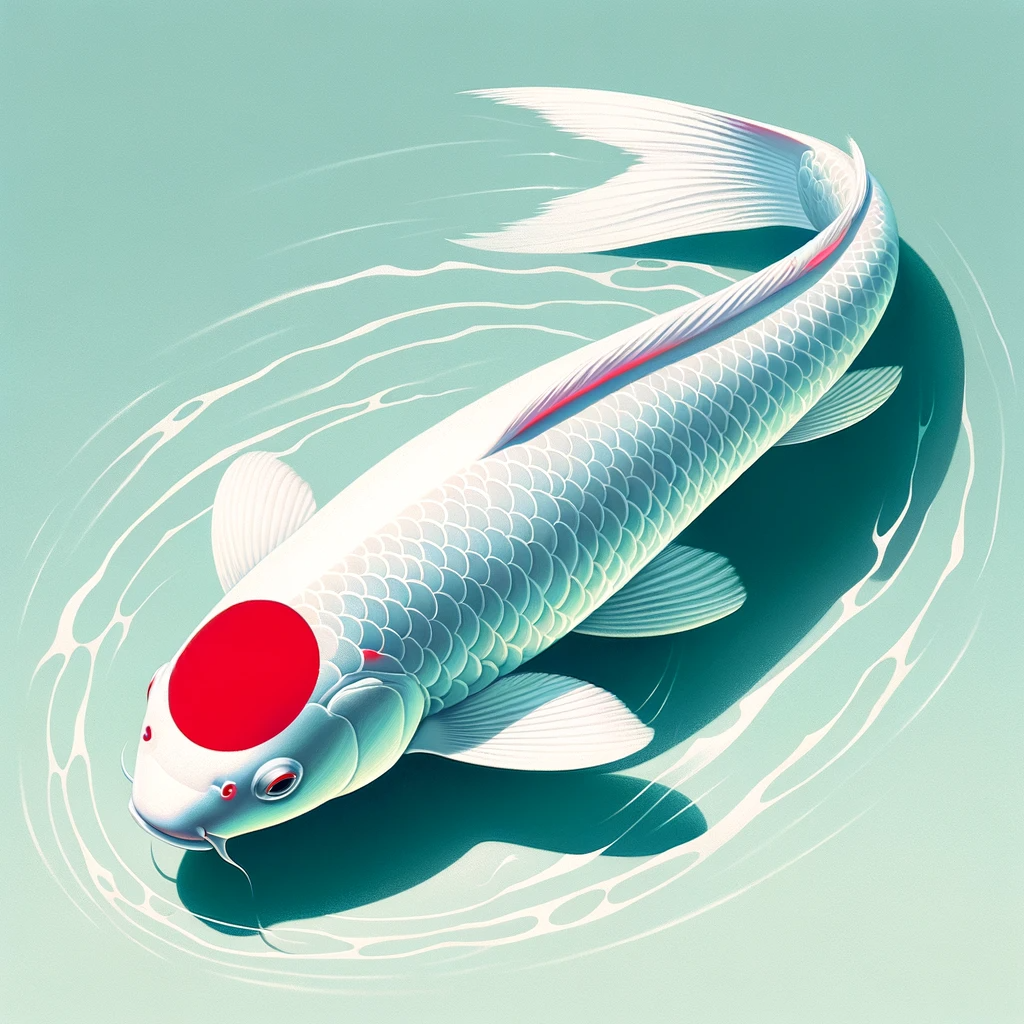
The Tancho koi is a cherished variety within the koi community, renowned for its simplicity and elegance that evoke the Japanese flag. Here's a detailed description of the Tancho koi:
-
Defining Mark: The hallmark of the Tancho is the single red spot on the head. This spot should be circular and well-centered, resembling the red sun disc of the Japanese flag. The term "Tancho" actually refers to the Japanese crane, which shares this distinctive red mark on its head.
-
Body Color: Apart from the red spot, the rest of the body should be a pure white, free from any blemishes or additional coloring. The whiteness should be uniform and bright, serving as a pristine backdrop for the red spot.
-
Shape of the Red Spot: The red spot, or "hi", should be round and well-defined. It shouldn't spread onto the body or be irregularly shaped. The quality of the red color is also important—it should be a deep, vibrant red.
-
Body Shape: Tancho koi should have a strong, sturdy body. They are typically bred to have a broad and balanced body shape, reflecting good health and genetic quality.
-
Fins: The fins of a Tancho koi should be clear and free of any coloration, matching the white of the body.
-
Variations: While the most iconic Tancho is the Tancho Kohaku, which has a Kohaku pattern with the single red spot, there are other variations such as Tancho Sanke and Tancho Showa, which have additional colors but still feature the characteristic red spot on white head.
-
Size and Symmetry: The size and symmetry of the red spot are critical in judging the quality of a Tancho. It should be proportionate to the size of the head and the body of the fish.
Tancho koi are especially popular during koi shows and are regarded highly when the red spot is perfectly round and centered. The beauty of the Tancho lies in its simplicity and the stark contrast between the white of the body and the red spot on the head.
Bekko
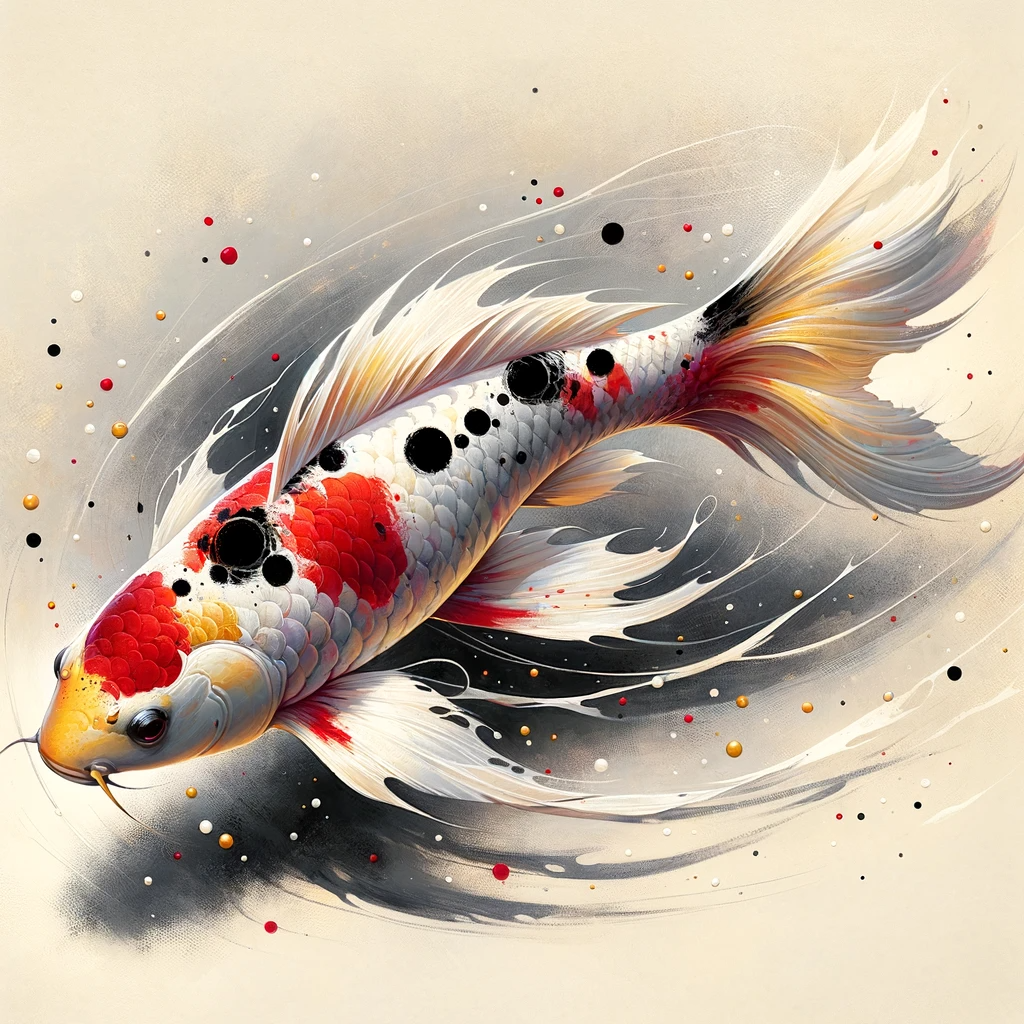
A Bekko koi is a traditional variety of koi fish that is admired for its elegant simplicity. Here are the defining features of a Bekko:
-
Base Color: Bekko koi have a solid, non-metallic base color which is typically white (Shiro Bekko), red (Aka Bekko), or yellow (Ki Bekko). The base should be a clean and consistent shade free from blemishes or discoloration.
-
Black Markings: The defining characteristic of a Bekko is the sumi (black) markings that overlay the base color. These markings should be well-defined and strategically placed, enhancing the fish's overall appearance. Unlike Utsuri, which have a black base color, Bekko koi have black patterns over a lighter base color.
-
Pattern: The sumi should appear as islands rather than a continuous pattern, and it's typically limited to the back of the fish, not crossing the lateral line onto the belly. The edges of the black markings should be sharp and clear, known as "kiwa".
-
Body Shape: Bekko should have a strong and well-proportioned body, as is desirable in all koi varieties. A balanced body shape indicates good health and genetic quality.
-
Fins: The fins of a Bekko are usually clear or white with no sumi, although a small amount of sumi in the fins can be acceptable depending on the show or breed standards.
-
Size and Growth: Bekko koi have the potential to grow quite large, and a larger specimen with a good pattern and body shape is especially valued.
-
Balance and Harmony: The overall impression of a Bekko should be one of balance and harmony. The sumi markings should complement the base color and not overwhelm it.
The Bekko is often appreciated for its understated beauty. In a pond, they provide a contrast to more vibrantly patterned koi while maintaining a subtle elegance.
Utsuri
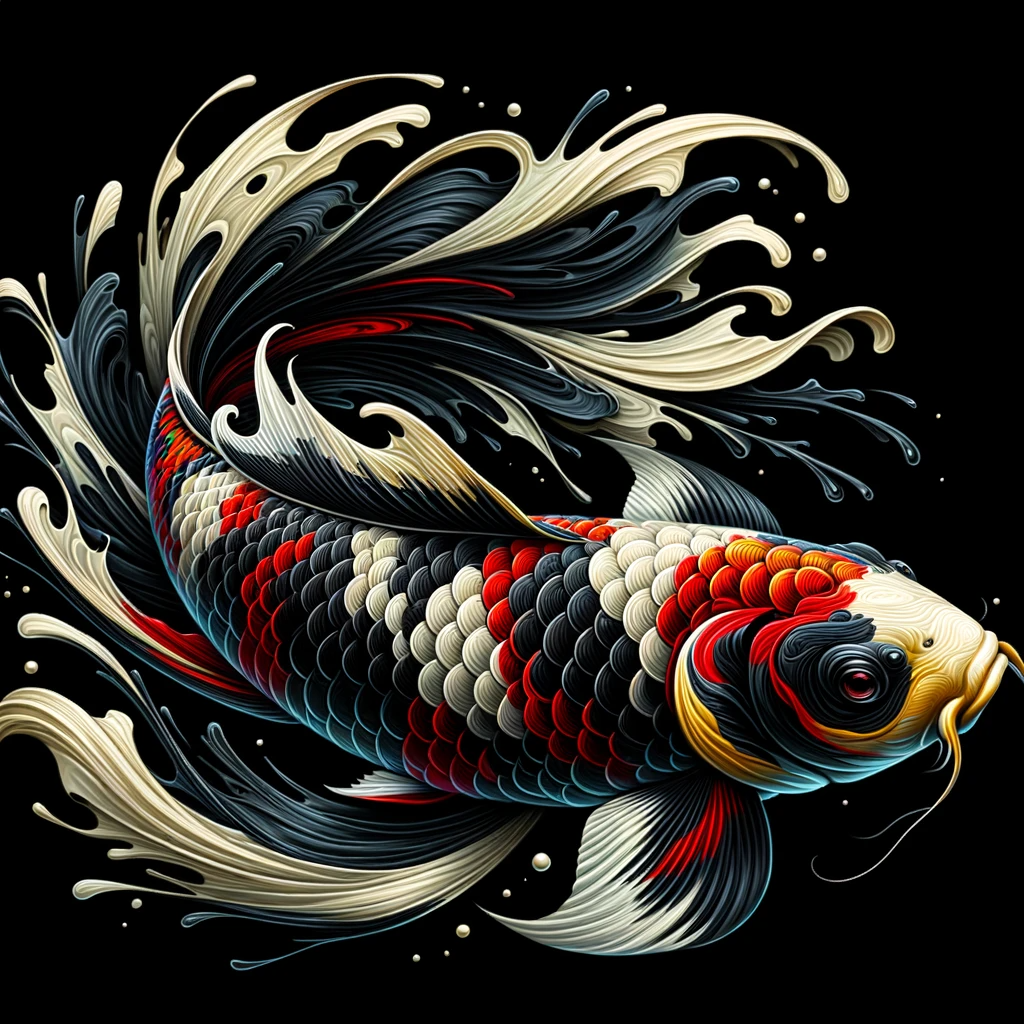
Utsuri koi are striking and popular members of the koi community, known for their bold contrasting colors and patterns. Here are the defining features of Utsuri koi:
-
Base Color: Utsuri have a strong, deep black base color known as "sumi". This black covers the majority of the body and is the canvas on which other colors appear.
-
Contrasting Pattern: On top of the black base, Utsuri display patches of either white (Shiro Utsuri), red (Hi Utsuri), or yellow (Ki Utsuri). These colors form a pattern across the fish's body, often in a wrapping, band-like style.
-
Pattern Distribution: The pattern on an Utsuri is ideally balanced between the sumi and the contrasting color. Good Utsuri have a pattern that is evenly distributed on both sides of the body, creating a symmetrical look.
-
Head Pattern: The head of an Utsuri often features a continuation of the body pattern, with the contrasting color crossing over the sumi. A balanced pattern that includes a 'menware' or 'split head' pattern, where the color divides the head symmetrically, is highly valued.
-
Pectoral Fins: The "motoguro" is a desirable trait in which the base of the pectoral fins has a solid black color that seems to 'bleed' up from the base.
-
Skin Quality: The skin of an Utsuri should be of high quality, with the sumi appearing lacquer-like and the contrasting color being bright and clear.
-
Body Shape: Utsuri should have a robust and well-proportioned body shape, as is typical for koi, indicative of good health and vitality.
-
Dynamic Appearance: The appeal of Utsuri is in their dynamic and impactful appearance, with the sumi providing a dramatic background for the other colors.
Utsuri koi can change significantly as they age, with the sumi developing and changing over time, which adds to their allure. They are a favorite among koi enthusiasts for their bold patterns and striking contrasts.
Kujaku
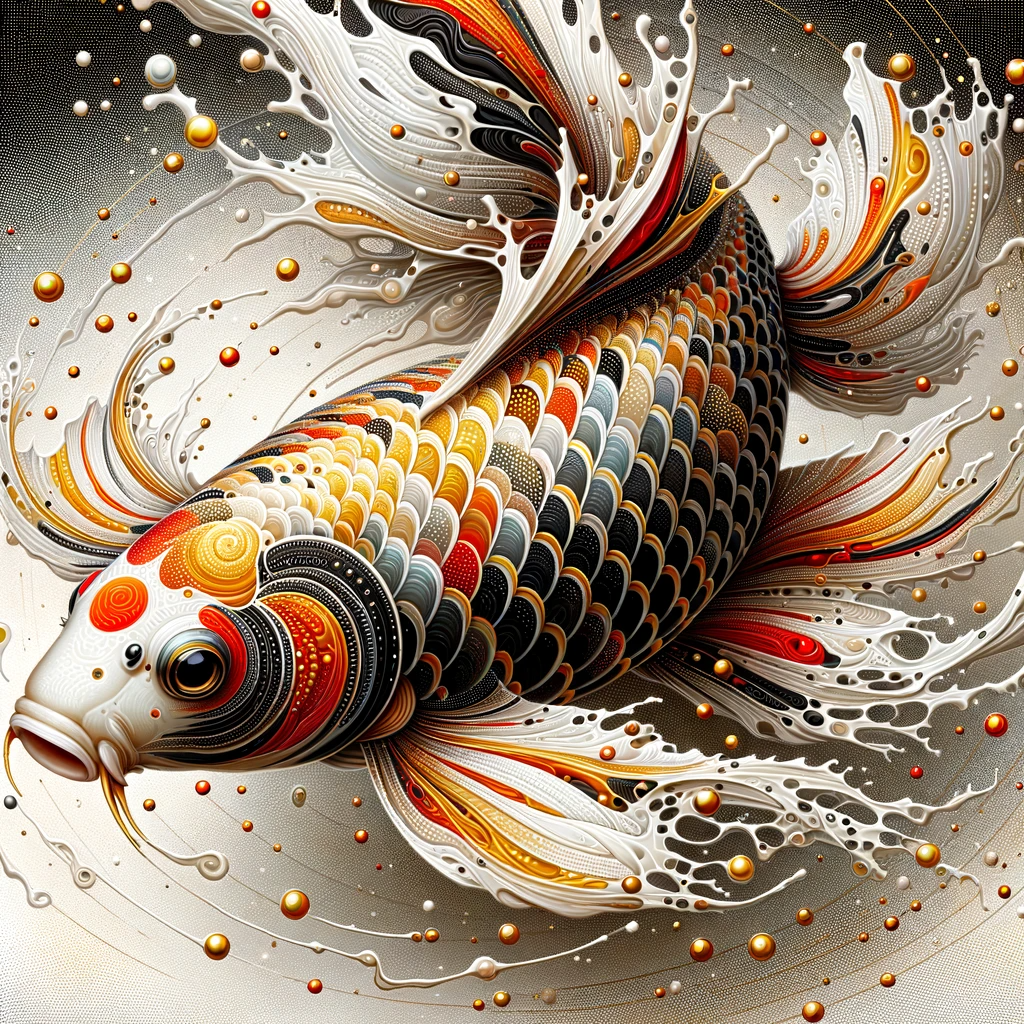
The Kujaku koi, or Kujaku Ogon, which translates to "Peacock," is a metallic or Ogon koi with a reticulated net-like pattern. It is a hybrid variety that combines the vibrant colors of the Kohaku with the metallic sheen and scalation of the Matsuba, resulting in a strikingly ornamental fish. Here are the defining features of a Kujaku koi:
-
Metallic Sheen: Kujaku koi are part of the Hikarimoyo class, which means they have a lustrous, metallic sheen. This metallic quality is one of their most distinctive features, giving them a sparkling appearance in the sunlight.
-
Color Patterns: Kujaku typically have a white base color overlaid with red (hi) patterns similar to those of a Kohaku. The quality and vibrancy of the red are crucial, and it should appear bright against the white background.
-
Reticulated Scales: The scales of a Kujaku have a dark, net-like pattern called "fukurin" that overlays the red and white, giving a pine cone effect. This netting is a defining trait and should be uniform and clearly defined over the body.
-
Body Shape: They should exhibit the standard koi body shape, which is strong and well-proportioned. The fish's conformation should be balanced and symmetrical.
-
Fins: The fins may have a metallic sheen like the body, with possible red patterning that reflects the body's coloration. The fins should be clear of any defects and proportional to the body.
-
Head: The head may carry the hi pattern and should maintain the metallic sheen. A clear head with well-balanced patterning is preferred.
-
Balance of Pattern: The beauty of a Kujaku lies in the harmony between the red and white patterns and the dark reticulations of the scales. The pattern should be aesthetically pleasing and enhance the fish's metallic luster.
Kujaku koi are admired for their complex beauty and the shimmering effect created by their metallic scales. They are a favorite in koi shows and for hobbyists who desire a standout fish for their pond.
Tekuno
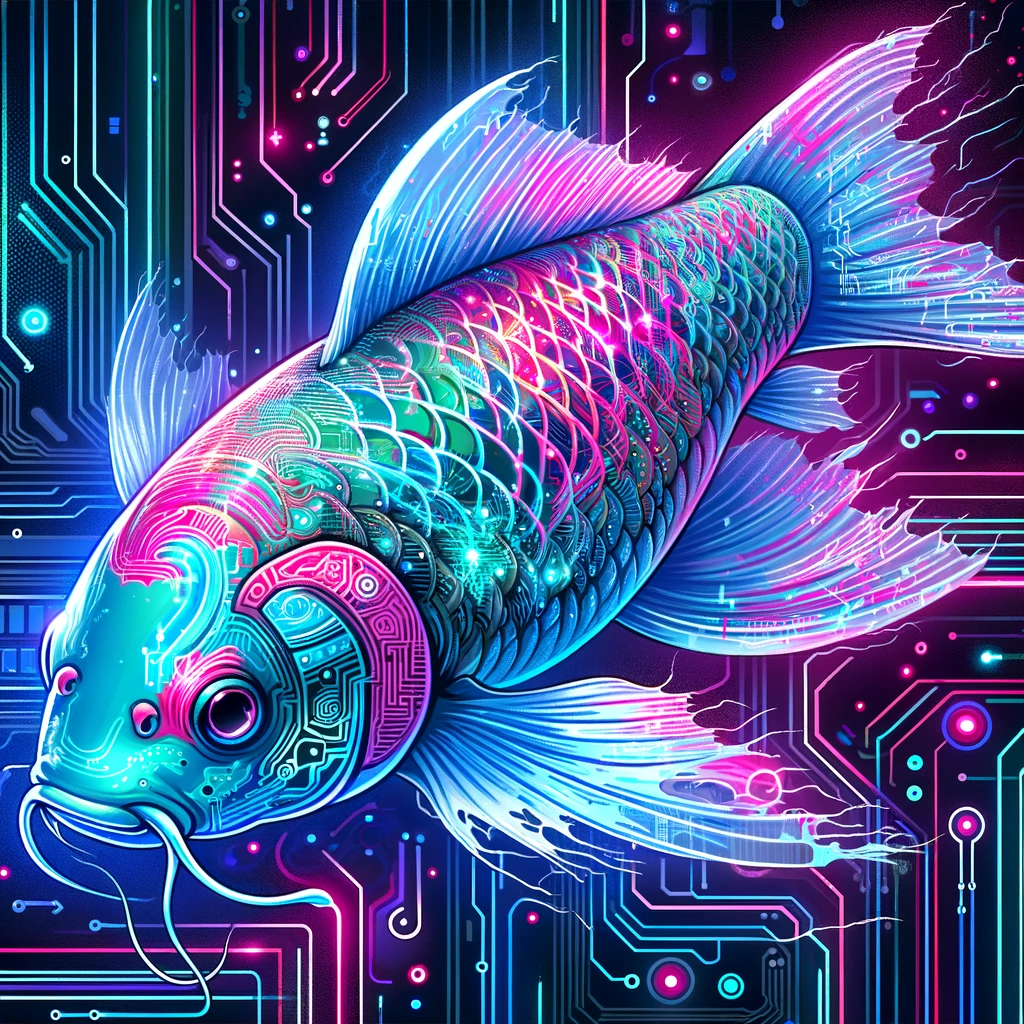
The Tekuno Koi, a variety of koi fish that merges traditional beauty with futuristic cybernetic enhancements:
-
Base Color: The Tekuno Koi features a sleek, silver metallic base that mimics the look of brushed aluminum, giving it a contemporary and high-tech appearance.
-
Cybernetic Patterns: Overlaying the silver base are intricate circuitry patterns that glow with neon accents. These patterns resemble motherboard tracks and microchip designs, pulsating with artificial energy.
-
Luminous Accents: The Tekuno Koi is adorned with bioluminescent spots that resemble LED lights, which can change color based on the fish's mood and surrounding environment.
-
Fins and Tail: The fins and tail are semi-translucent, with fiber-optic threads running through them, casting a gentle glow and leaving a trail of light as the fish swims.
-
Eyes: Its eyes are like small, glowing orbs, equipped with miniature lenses that give the impression of scanning its surroundings.
-
Body Shape: The Tekuno maintains the robust, streamlined body shape of traditional koi but with a slightly angular form, hinting at its synthetic modifications.
-
Scale Texture: The scales of the Tekuno Koi have a holographic finish, reflecting light in a spectrum of colors, reminiscent of a compact disc surface.
-
Interactive Behavior: The Tekuno Koi is interactive, capable of responding to electronic devices and stimuli in its environment, making it a living, swimming piece of interactive art.
This Tekuno Koi, captures the imagination by blending the organic grace of a living fish with elements of cyberpunk aesthetics and modern technology.
Robotto
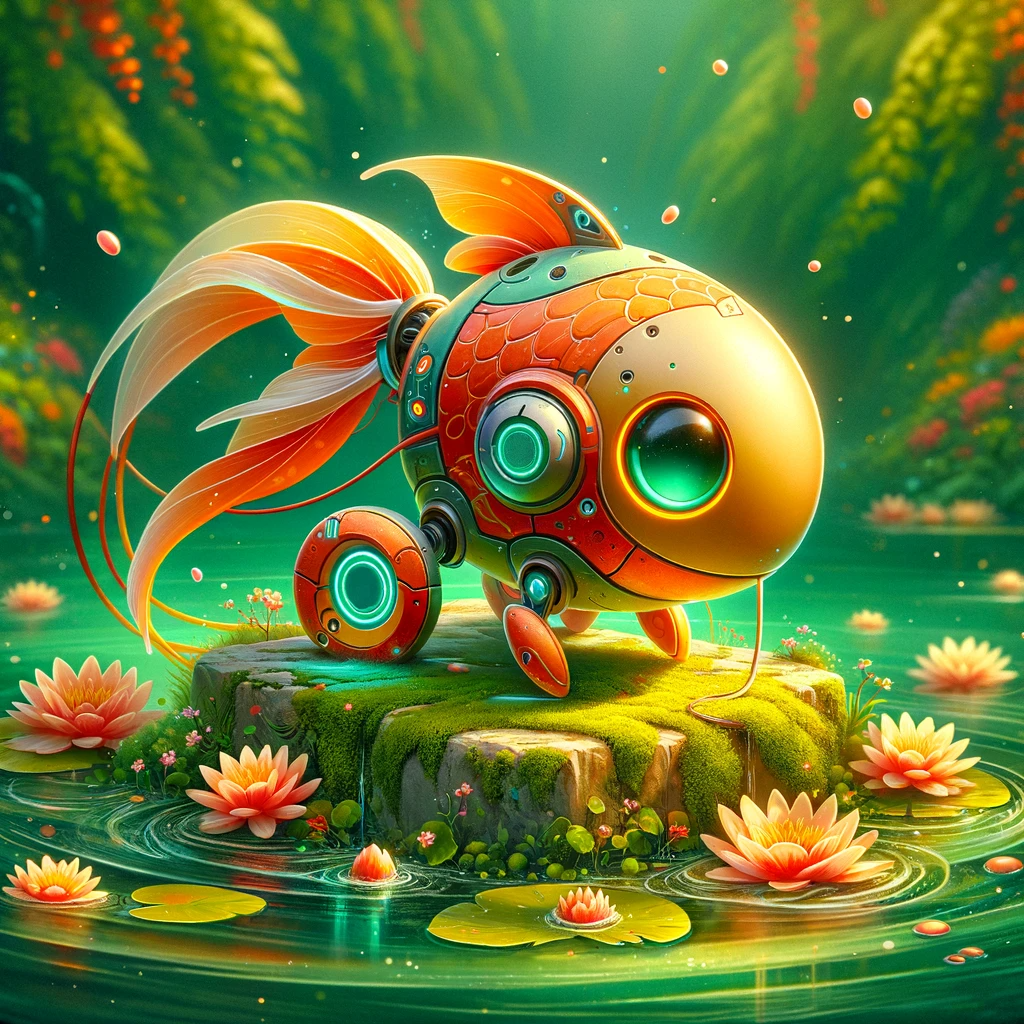
A Robotto Koi, a variety of mechanical koi fish designed with an array of futuristic elements:
-
Structure: The Robotto Koi boasts a sleek, aerodynamic body constructed from high-gloss, titanium-like material, giving it a durable yet elegant form.
-
Coloration: This robotic fish is painted in pearlescent shades, with iridescent scales that shift color as it moves, ranging from electric blues to radiant purples.
-
Illumination: Throughout its chassis, the Robotto Koi features ambient light strips that pulse and change colors, mimicking the natural flow of water and adding to its aquatic illusion.
-
Fins and Tail: Instead of traditional fins, it has flexible, silicone-based appendages with embedded fiber optics that gracefully undulate, propelling the Robotto Koi through its environment.
-
Eyes: Its eyes are spherical OLED screens that can display a range of emotive expressions and patterns, from curious swirling to calm ripples, reflecting its responsive nature.
-
Interactive Features: Equipped with sensors, the Robotto Koi interacts with its surroundings, responding to environmental changes and presence of life with gentle beeps and harmonious tones.
-
Water Purification: As it glides through the water, the Robotto Koi doubles as a purifying agent, with micro-filters that clean the water, leaving a trail of crystal-clear liquid behind.
-
Eco-Powered: Harnessing solar technology, the Robotto Koi's scales absorb sunlight, which is converted into clean energy to power its movements and internal systems.
The Robotto Koi is a blend of advanced robotics and environmental stewardship, a testament to the harmonious integration of technology into nature, designed not only to inspire but to sustain the ecosystem it inhabits.